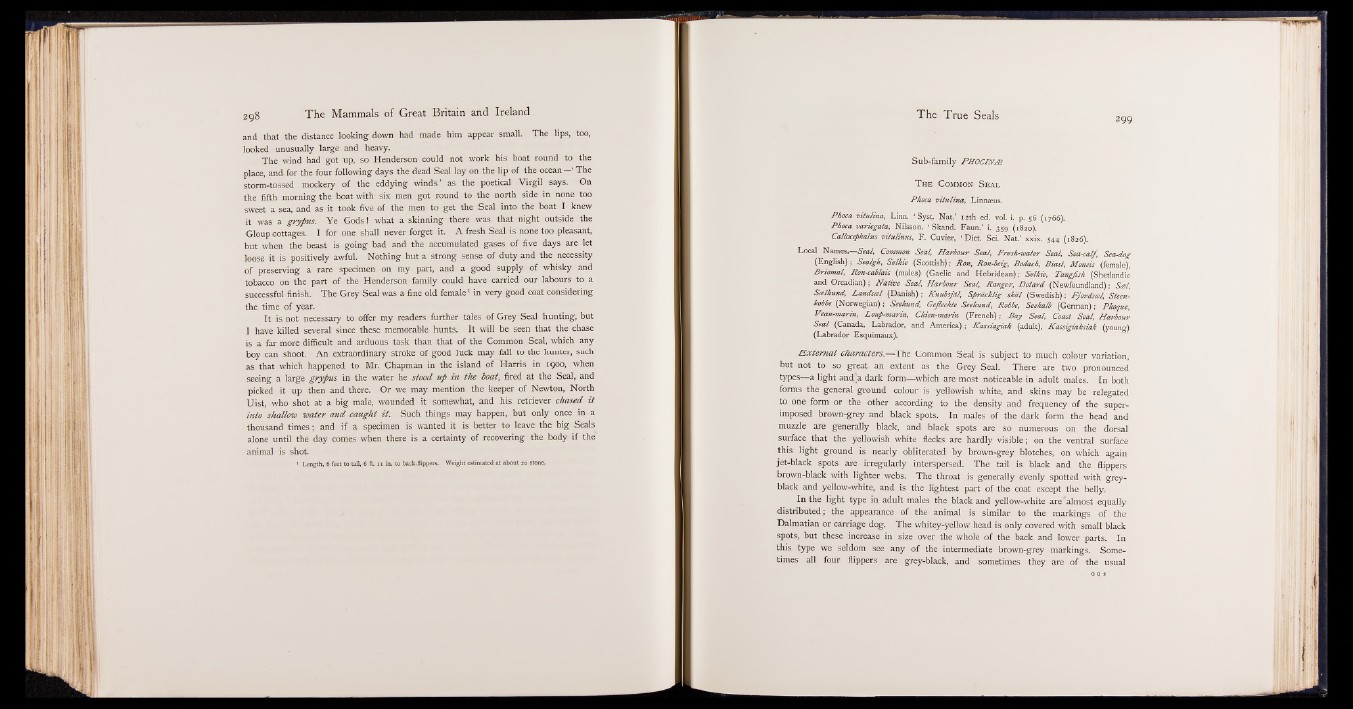
and that the distance looking down had made him appear small. The lips, too,
looked unusually large and heavy.
The wind had got up, so Henderson could not work his boat round to the
place, and-for the four following days the dead Seal lay on the lip of the ocean—‘ The
storm-tossed mockery of the eddying winds ’ as the poetical Virgil says. On
the fifth morning the boat with six men got round to the north side in none too
sweet a sea, and as it took five of the men to get the Seal into the boat I knew
it was a grypus. Ye Gods! what a skinning there was that night outside the
Gloup cottages. I for one shall never forget it. A fresh Seal is none too pleasant,
but when the beast is going bad and the accumulated gases of five days are let
loose it is positively awful. Nothing but a strong sense of duty and the necessity
of preserving a rare specimen on my part, and a good supply of whisky and
tobacco on the part of the Henderson family could have carried our labours to a
successful finish. The Grey Seal was a fine old female1 in very good coat considering
the time of year.
It is not necessary to offer my readers further tales of Grey Seal hunting, but
I have killed several since these memorable hunts. It will be seen that the chase
is a far more difficult and arduous task than that of the Common Seal, which any
boy can shoot. An extraordinary stroke of good luck may fall to the hunter, such
as that which happened to Mr. Chapman in the island of Harris in 1900, when
seeing a large grypus in the water he stood up in the boat, fired at the Seal, and
picked it up then and there. Or we may mention the keeper of Newton, North
Uist, who shot at a big male, wounded it somewhat, and his retriever chased it
into shallow water and caught it. Such things may happen, but only once in a
thousand times; and if a specimen is wanted it is better to leave the big Seals
alone until the day comes when there is a certainty of recovering the body if the
animal is shot.
1 Length, 6 feet to tail, 6 ft n in. to back-flippers. Weight estimated at about 20 stone.
Sub-family P h o c in j z
T h e C o m m o n S e a l
Phoca vitulina, Linnaeus.
Phoca vitulina, Linn. ‘ Syst. Nat.’ 12th ed. vol. i. p. 56 (1766).
Phoca variegata, Nilsson, ‘ Skand. Faun.’ i. 359 (1820).
Callocephdlus vitulinus, F. Cuvier, ‘ Diet. Sci. Nat.’ xxix. 544 (1826).
Local Names. Seal, Common Seal, Harbour Seal, Fresh-water Seal, Sea-calf, Sea-dog
(English); Sealgh, Selkie (Scottish); Ron, Ron-beig, Bodach, Biast, Moneis (female),
Briomal, Ron-cablais (males) (Gaelic and Hebridean); Selkie, Tangfish (Shetlandic
and Orcadian); Native Seal, Harbour Seal, Ranger, D otard (Newfoundland); Seel,
Seelhund, Landseel (Danish); Knubsj'dl, Spr&cklig sk'&l (Swedish); Fjordseel, Steen-
kobbe (Norwegian); Seehund, Gefleckte Seehund, Robbe, Seekalb (German); Phoque,
Veau-marin, Loup-marin, Chien-marin (French); Bay Seal, Coast Seal, Harbour
S eal (Canada, Labrador, and America); Kassiagiak (adult), Kassigiaksiak (young)
(Labrador Esquimaux).
E xtern al characters.— The Common Seal is subject to much colour variation,
but not to so great an extent as the Grey Seal. There are two pronounced
types a light and'a dark form—which are most noticeable in adult males. In both
forms the general ground colour is yellowish white, and skins may be relegated
to one form or the other according to the density and frequency of the superimposed
brown-grey and black spots. In males of the dark form the head and
muzzle are generally black, and black spots are so numerous on the dorsal
surface that the yellowish white flecks are hardly visible; on the ventral surface
this light ground is nearly obliterated by brown-grey blotches, on which again
jet-black spots are irregularly interspersed. The tail is black and the flippers
brown-black with lighter webs. The throat is generally evenly spotted with grey-
black and yellow-white, and is the lightest part of the coat except the belly.
In the light type in adult males the black and yellow-white are*almost equally
distributed; the appearance of the animal is similar to the markings of the
Dalmatian or carriage dog. The whitey-yellow head is only covered with small black
spots, but these increase in size over the whole of the back and lower parts. In
this type we seldom see any of the intermediate brown-grey markings. Sometimes
all four flippers are grey-black, and sometimes they are of the usual